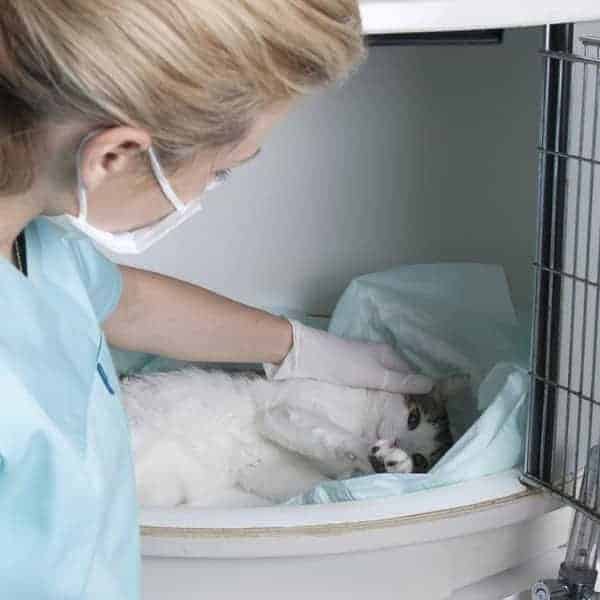WRITTEN BY: Harrie Phillips
BAdVocEd (VocEd&Trng), RVN, DipVN (Surgical, ECC), DipBus, DipTDD, TAA.

The Gastrostomy Tube (aka G-Tube), including the Percutaneous Endoscopic Gastrostomy tube (PEG tube), needs to be left insitu for at least 7 days prior to removal. Here’s a few things you need to know as a veterinary nurse about managing patients with feeding tubes.
Once a G-tube has been placed feeding cannot commence for 12 hours, this enables a temporary stoma (or seal) to form in the stomach wall. This stoma formation ensures that no stomach content is able to contaminate the abdominal cavity. The tube itself must remain in place for at least 7 to 10 days to ensure a permanent stoma has formed prior to removal.
How long can a G-tube be left in?
A gastrostomy tube can be left in for long term tube feeding (1–6 months) as long as the tube remains in good condition. The stoma itself and tube integrity should be checked regularly. The stoma can be used for the rest of the patient’s life, as long as the tube is checked and replaced as necessary. Ultra long-term tubes are usually changed for low profile versions for patient comfort and to reduce the risk of it being damaged.
What about J-tubes?
Jejunostomy tubes, whilst not commonly used in clinical practice, are also recommended to be left in for 7 to 10 days prior to removal. This allows adhesions to form around the tube site and to prevent leakage back into the abdomen.
Why are feeding tubes used anyway?
When normal oral nutrition is not an option, the veterinarian may consider placing a feeding tube. Oral nutrition may not be an option, due to the patient being inappetant because of a disease process or as a preemptive measure when surgery is going to stop the patient being able to eat normally (I.e. for GIT, oral or facial surgery). There are a number of feeding tube options available and the choice of which tube to utilize will depend on the disease process, the patient themselves, cost to owner, monitoring available and the anticipated length of the assisted feeding. Generally speaking, the tube will be placed in a location that will utilize as much of the digestive tract as possible, with consideration for the reason for placement.
What feeding tubes are there?
The types of feeding tubes that can be placed are:-
- Naso-oesophageal (NE or NO tube)
- Small (5 to 8 Fr) tube threaded through the nose and down into the oesophagus
- Usually placed short term for use in hospital (3 to 7 days)
- Used in patients with a functional oesophagus, stomach, and intestines
- Naso-gastric (NG tube)
- Small (5 to 8 Fr) tube threaded through the nose and down into the stomach
- Usually placed short term for use in hospital (3 to 7 days)
- Used in patients with a functional oesophagus, stomach, and intestines
- Enables suctioning of the stomach (Great for Parvo puppies or those with motility issues!)
- Oesophageal tube (O-tube)/ Pharyngostomy tube
- Small gauge (8 to 20 Fr) tube surgically placed in the oropharynx
- Long term, in-hospital and at-home use, (1–20 weeks)
- Gastrostomy tube (G-tube)
- Surgically or endoscopically (PEG tube) placed in the stomach (can also be placed ‘blind’, but rare).
- 20- to 24-Fr Pezzer catheter is utilised
- Long-term use, can be permanent, depending on tube type selected
- Jejunostomy Tube (J-Tube)
- Small (5 to 8 Fr) tube surgically placed into the jejunum, bypassing the stomach.
- Used when the upper GI tract must be rested or when pancreatic stimulation must be decreased.
- Needs critical care monitoring in hospital. Usually placed short term for 3 to 10 days.
- As the jejunum has limited ‘storage’ area for food, a liquid diet is supplied via a CRI.
Total Parenteral Nutrition or Partial Parenteral Nutrition
Total parenteral nutrition (TPN) is used for patients that are unable to tolerate enteral (gastrointestinal) feeding. Partial Parenteral Nutrition (PPN) is used when the patient needs parenteral supplementation on top of enteral nutrition.
TPN & PPN are administered by a central line. It cannot be administered via a peripheral vein due to the osmolarity of the product. This is a highly specialised procedure and is usually only performed at suitably equipped specialist centres. The solution used to provide the nutrition is highly attractive to bacterial growth aseptic technique is of extreme importance to minimise the chances of systemic infection.
want to learn more?

ADVANCED CRITICAL CARE NURSING
SHORT COURSE
For those wishing to gain the ability to manage more difficult medical cases or post medical condition surgical procedures. You’ll learn all about nursing care plans, a method by which individualized care can be provided for your patients to aid in their recovery and management. Following on from this, you’ll cover specific nursing interventions that you can undertake. Urinary system and catheters are discussed in detail, along with other supportive nursing interventions such as oxygen therapy, nutritional support including feeding tubes and the management of tracheostomies. Critically ill and recumbent patients need a higher level of care and attention, learn about the necessities for managing those patients as well as best methods of transportation.
Check it out